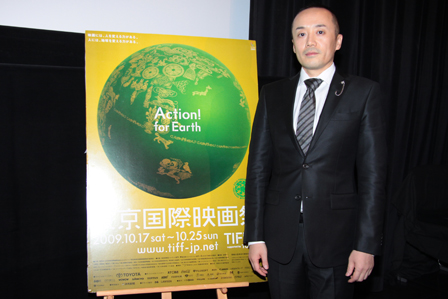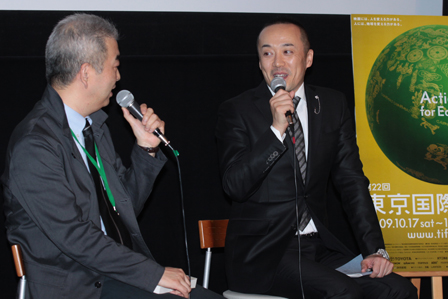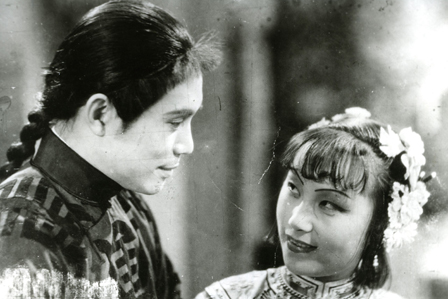2009.10.21
[Event Reports]
On forefront of the fantastic horror film genre! Wailing in Hollow Valley + The Leper Girl: Oct. 19th (Mon) Talk Show
Two films by Director Ma-Xu Weibang, Wailing in Hollow Valley and The Leper Girl was screened at the Roppongi Cinemart on Oct. 19th.
Wailing in Hollow Valley is a silent film shown in the projection speed of 18 frames per second. The Leper Girl is a talkie shown in 24 frames per second. Because of its projection requirements, there was a need to change the setting for the projector and we used the time to present the talk show.
The guest of the talk show was Riu Wenbing, the motion picture researcher who is also popular amongst the Asian film fans for his numerous literary works based upon uncompromising and well-documented research and also Kenji Ishizaka, the Programming Director of the Winds of Asia – Middle East.

The topic of the talk show started with the film Wailing inHollow Valley which screened first, and Riu entertained us with the mini-episode, informing us about the actor who played the detective and stole the show was the Director Ma-Xu Weibang and continued to introduce the Director’s portfolio.
The Director Ma-Xu was born in 1901, his original name was Xu. He married into the Ma family later on and combined the two family names together and began calling himself Ma-Xu. Ma-Xu began working for the film industry in Shanghai in 1928. He began his career as Art Department staff and actor, but made his directorial debut in 1926. Wailing in Hollow Valley was the director’s 3rd film.
In later years, Director Ma-Xu became a leading figure in the Chinese Fantastic Horror Films. His best film is considered to be, Song at Midnight produced in 1937. The film was produced later as a remake, The Phantom Lover with Leslie Cheung in 1995. According to the Riu’s research, the Nationalist government’s film censorship and the influence that Manchurian Incident gave to the film industry was enormous, and even in the city of Shanghai which was the Entertainment Film Base of the East began gaining the momentum for the production of left wing films and the Anti-Japanese films. This was also the time when the wave of the talkie movies began. The style of the film making began to change throughout the world including the Director Ma-Xu’s style.
Wailing in Hollow Valley was a film produced in 1930, which was just before the Manchurian Incident and The Leper Girl was produced in 1939. It is quite interesting to view and experience the film by contemplating on such historical background.

After the war, Ma-Xu moved his place of work to Hong Kong, but the low budget and short scheduled shooting was the way that Hong Kong operated. Ma-Xu’s style was to “take sufficient time to create a film” and Ma-Xu’s style was never accepted there. According to the history of the Chinese film, Ma-Xu Weibang has made numerous mediocre films during this period, which is quite an interesting information. Programming Director Kenji Ishizaka is very interested in selections of Ma-Xu Weibang’s films directed in Hong Kong. These films rare and aren’t even stored in the Film Archives in Beijing and Hong Kong. It is a very difficult task to recover these films, but the Program Director Kenji Ishizaka has received the information that the private film collector from Taiwan may own these films. May be we would be able to screen these selections in few years to come at the Tokyo International Film Festival.

In addition, the Director Ma-Xu’s original style as a Director in "featuring the deformity" may have origined from the unfortunate experience he had in the childhood, says Riu. The leading actress of The Leper Girl, Tan In’s "Intense eye make-up" episode, and the Programming Director Ishizaka’s introduction on South East Asia and also variety of topics were introduced, but the talk show came to the end and The Leper Girl was screened after the 10 minutes intermission.
Wailing in Hollow Valley is a silent film shown in the projection speed of 18 frames per second. The Leper Girl is a talkie shown in 24 frames per second. Because of its projection requirements, there was a need to change the setting for the projector and we used the time to present the talk show.
The guest of the talk show was Riu Wenbing, the motion picture researcher who is also popular amongst the Asian film fans for his numerous literary works based upon uncompromising and well-documented research and also Kenji Ishizaka, the Programming Director of the Winds of Asia – Middle East.

Motion picture researcher, Riu Wenbing
The topic of the talk show started with the film Wailing inHollow Valley which screened first, and Riu entertained us with the mini-episode, informing us about the actor who played the detective and stole the show was the Director Ma-Xu Weibang and continued to introduce the Director’s portfolio.
The Director Ma-Xu was born in 1901, his original name was Xu. He married into the Ma family later on and combined the two family names together and began calling himself Ma-Xu. Ma-Xu began working for the film industry in Shanghai in 1928. He began his career as Art Department staff and actor, but made his directorial debut in 1926. Wailing in Hollow Valley was the director’s 3rd film.
In later years, Director Ma-Xu became a leading figure in the Chinese Fantastic Horror Films. His best film is considered to be, Song at Midnight produced in 1937. The film was produced later as a remake, The Phantom Lover with Leslie Cheung in 1995. According to the Riu’s research, the Nationalist government’s film censorship and the influence that Manchurian Incident gave to the film industry was enormous, and even in the city of Shanghai which was the Entertainment Film Base of the East began gaining the momentum for the production of left wing films and the Anti-Japanese films. This was also the time when the wave of the talkie movies began. The style of the film making began to change throughout the world including the Director Ma-Xu’s style.
Wailing in Hollow Valley was a film produced in 1930, which was just before the Manchurian Incident and The Leper Girl was produced in 1939. It is quite interesting to view and experience the film by contemplating on such historical background.

Appearing on the left side is Programming Director Kenji Ishizaka
After the war, Ma-Xu moved his place of work to Hong Kong, but the low budget and short scheduled shooting was the way that Hong Kong operated. Ma-Xu’s style was to “take sufficient time to create a film” and Ma-Xu’s style was never accepted there. According to the history of the Chinese film, Ma-Xu Weibang has made numerous mediocre films during this period, which is quite an interesting information. Programming Director Kenji Ishizaka is very interested in selections of Ma-Xu Weibang’s films directed in Hong Kong. These films rare and aren’t even stored in the Film Archives in Beijing and Hong Kong. It is a very difficult task to recover these films, but the Program Director Kenji Ishizaka has received the information that the private film collector from Taiwan may own these films. May be we would be able to screen these selections in few years to come at the Tokyo International Film Festival.

The Leper Girl’s Tan In’s special eye make-up
In addition, the Director Ma-Xu’s original style as a Director in "featuring the deformity" may have origined from the unfortunate experience he had in the childhood, says Riu. The leading actress of The Leper Girl, Tan In’s "Intense eye make-up" episode, and the Programming Director Ishizaka’s introduction on South East Asia and also variety of topics were introduced, but the talk show came to the end and The Leper Girl was screened after the 10 minutes intermission.









